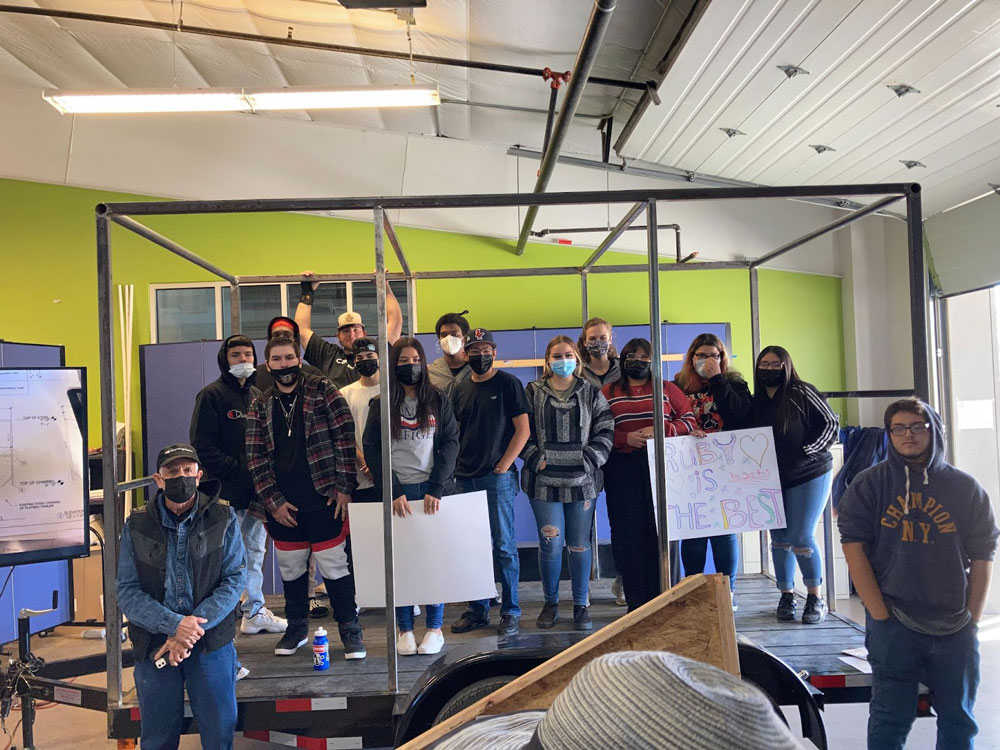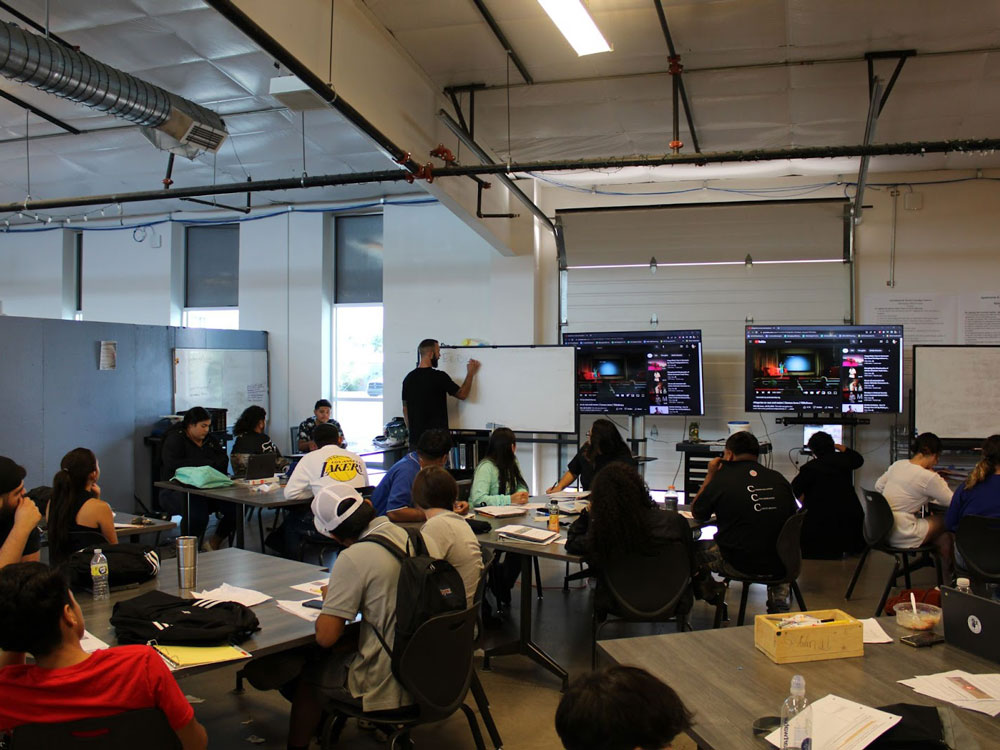Explore
We do high school differently.
Explore
We do high school differently.
Explore
We do high school differently.
Explore the ACE…
Our Model
At ACE, education is active. Our curriculum is practical and hands-on, emphasizing projects that teach real skills and put academic concepts to work. Our industry partners bridge the gap between learning and doing, ensuring our students get the experience, skills, and credentials they need to succeed after graduation.
We offer both day and evening programs to ensure that every student — whether returning to school after an absence, raising a family, or holding down a job — has the individualized support they need to succeed. Rather than focusing on lectures and seat time, ACE shifts the focus of high school education onto real world projects and experiences that allow students to put what they’re learning into practice.
Our Model
At ACE, education is active. Our curriculum is practical and hands-on, emphasizing projects that teach real skills and put academic concepts to work. Our industry partners bridge the gap between learning and doing, ensuring our students get the experience, skills, and credentials they need to succeed after graduation.
We offer both day and evening programs to ensure that every student — whether returning to school after an absence, raising a family, or holding down a job — has the individualized support they need to succeed. Rather than focusing on lectures and seat time, ACE shifts the focus of high school education onto real world projects and experiences that allow students to put what they’re learning into practice.
Our Curriculum
At ACE, students learn all academic subjects through projects. These projects are focused on topics from the Architecture, Construction, and Engineering (ACE) industries, and are developed in accordance with our Industry Framework. Project based learning provides active, hands-on, and relevant educational experiences. Student projects are designed based on actual commercial construction projects in New Mexico. ACE educators take challenging problems from these commercial projects and design Student Projects in collaboration with our expert industry partners. These partners help our educators ensure that they are providing students with a relevant, dynamic, and purposeful education.
ACE students must publicly demonstrate project completion as well as mastery of skills and content during Student Exhibitions. Exhibitions take place at least once per trimester and provide students the opportunity to present and discuss their projects with industry experts, families, community members, and teachers.
The ACE curriculum empowers our students to develop meaningful skills and knowledge through expert mentorship and real-life projects that tangibly contribute to our community.
Our Curriculum
At ACE, students learn all academic subjects through projects. These projects are focused on topics from the Architecture, Construction, and Engineering (ACE) industries, and are developed in accordance with our Industry Framework. Project based learning provides active, hands-on, and relevant educational experiences. Student projects are designed based on actual commercial construction projects in New Mexico. ACE educators take challenging problems from these commercial projects and design Student Projects in collaboration with our expert industry partners. These partners help our educators ensure that they are providing students with a relevant, dynamic, and purposeful education.
ACE students must publicly demonstrate project completion as well as mastery of skills and content during Student Exhibitions. Exhibitions take place at least once per trimester and provide students the opportunity to present and discuss their projects with industry experts, families, community members, and teachers.
The ACE curriculum empowers our students to develop meaningful skills and knowledge through expert mentorship and real-life projects that tangibly contribute to our community.
Assessment and Grading
At ACE Leadership High School, assessment and grading look different than they do in most traditional schools; we employ a mastery approach to learning. This means that students have multiple opportunities to provide evidence that they have met the learning outcomes for each credit in a project.
Students can earn different course credits in a project. Credits are earned through demonstration of mastery of Common Core, National, and State Standards. Each course credit that is available in a project will have specific Learning Outcomes tied to that credit. At the end of each trimester, teachers look over all of the evidence collected regarding how a student has performed on each Learning Outcome. A student's final grade, and whether they have earned credit, is determined by whether or not they have demonstrated proficiency in the Learning Outcomes aligned to each credit.
Throughout a project, student work and assignments are aligned to one or more student learning outcomes and targets. Teachers use a standards-based grading approach to determine to what extent the student’s performance on the assignment reflects proficiency. Teachers will share with students to what extent they have demonstrated proficiency and provide feedback through specific, actionable comments to help students understand their learning and take steps on how to improve.
We calculate final grades by converting learning outcomes aligned to each for course to a course grade:
4: Student demonstrates proficiency or mastery in 90% of learning outcomes.
3: Student demonstrates proficiency or mastery in 70% of learning outcomes.
NC: No credit: student does not produce enough evidence to demonstrate proficiency in 70% of learning outcomes and does not earn credit.
Assessment and Grading
At ACE Leadership High School, assessment and grading look different than they do in most traditional schools; we employ a mastery approach to learning. This means that students have multiple opportunities to provide evidence that they have met the learning outcomes for each credit in a project.
Students can earn different course credits in a project. Credits are earned through demonstration of mastery of Common Core, National, and State Standards. Each course credit that is available in a project will have specific Learning Outcomes tied to that credit. At the end of each trimester, teachers look over all of the evidence collected regarding how a student has performed on each Learning Outcome. A student's final grade, and whether they have earned credit, is determined by whether or not they have demonstrated proficiency in the Learning Outcomes aligned to each credit.
Throughout a project, student work and assignments are aligned to one or more student learning outcomes and targets. Teachers use a standards-based grading approach to determine to what extent the student’s performance on the assignment reflects proficiency. Teachers will share with students to what extent they have demonstrated proficiency and provide feedback through specific, actionable comments to help students understand their learning and take steps on how to improve.
We calculate final grades by converting learning outcomes aligned to each for course to a course grade:
4: Student demonstrates proficiency or mastery in 90% of learning outcomes.
3: Student demonstrates proficiency or mastery in 70% of learning outcomes.
NC: No credit: student does not produce enough evidence to demonstrate proficiency in 70% of learning outcomes and does not earn credit.

Senior Capstone Project
The Capstone Project is the culminating experience where students prepare for their transition after high school. The Driving Question for the Senior Capstone Project is “How do I use the skills I have gained at ACE to develop a realistic plan to successfully transition into a meaningful career and healthy life?” Capstone students gain core academic skills, complete their final course requirements, and reflect and synthesize what they learned over their high school career. In our Public Capstone Exhibitions, students tell their story, their plan for transition, and present evidence of learning to demonstrate that they embody the ACE Leadership Graduate Profile.
ACE is a founding member of the NM Innovative Assessment Community of Practice and is proud of our work spearheading capstone projects in New Mexico. ACE Capstone Project aligns the school with the state graduation requirements, including the NM Public Education Department’s Demonstration of Competency. Therefore, all students must take and pass the Capstone project to graduate.
Senior Capstone Project
The Capstone Project is the culminating experience where students prepare for their transition after high school. The Driving Question for the Senior Capstone Project is “How do I use the skills I have gained at ACE to develop a realistic plan to successfully transition into a meaningful career and healthy life?” Capstone students gain core academic skills, complete their final course requirements, and reflect and synthesize what they learned over their high school career. In our Public Capstone Exhibitions, students tell their story, their plan for transition, and present evidence of learning to demonstrate that they embody the ACE Leadership Graduate Profile.
ACE is a founding member of the NM Innovative Assessment Community of Practice and is proud of our work spearheading capstone projects in New Mexico. ACE Capstone Project aligns the school with the state graduation requirements, including the NM Public Education Department’s Demonstration of Competency. Therefore, all students must take and pass the Capstone project to graduate.

Our Programs
ACE Leadership High School has a traditional day program much like other high schools. ACE also offers an Evening Program that allows students the opportunity to still earn their high school diploma, just in a different format and learning system.
The Evening Program is perfect for students that may have dropped out and now want to return to school. The Evening Program is also for those students that want a flexible school schedule. The Evening Program allows students a more flexible option to earn their high school diploma. The Evening Program runs Monday-Thursday from 4-7.
Our Programs
ACE Leadership High School has a traditional day program much like other high schools. ACE also offers an Evening Program that allows students the opportunity to still earn their high school diploma, just in a different format and learning system.
The Evening Program is perfect for students that may have dropped out and now want to return to school. The Evening Program is also for those students that want a flexible school schedule. The Evening Program allows students a more flexible option to earn their high school diploma. The Evening Program runs Monday-Thursday from 4-7.


Work-Based Learning
Work-Based Learning
The Capstone Project is the culminating experience where students prepare for their transition after high school. The Driving Question for the Senior Capstone Project is “How do I use the skills I have gained at ACE to develop a realistic plan to successfully transition into a meaningful career and healthy life?” Capstone students gain core academic skills, complete their final course requirements, and reflect and synthesize what they learned over their high school career. In our Public Capstone Exhibitions, students tell their story, their plan for transition, and present evidence of learning to demonstrate that they embody the ACE Leadership Graduate Profile.
ACE is a founding member of the NM Innovative Assessment Community of Practice and is proud of our work spearheading capstone projects in New Mexico. ACE Capstone Project aligns the school with the state graduation requirements, including the NM Public Education Department’s Demonstration of Competency. Therefore, all students must take and pass the Capstone project to graduate.

ACE - A Community School

ACE - A Community School

